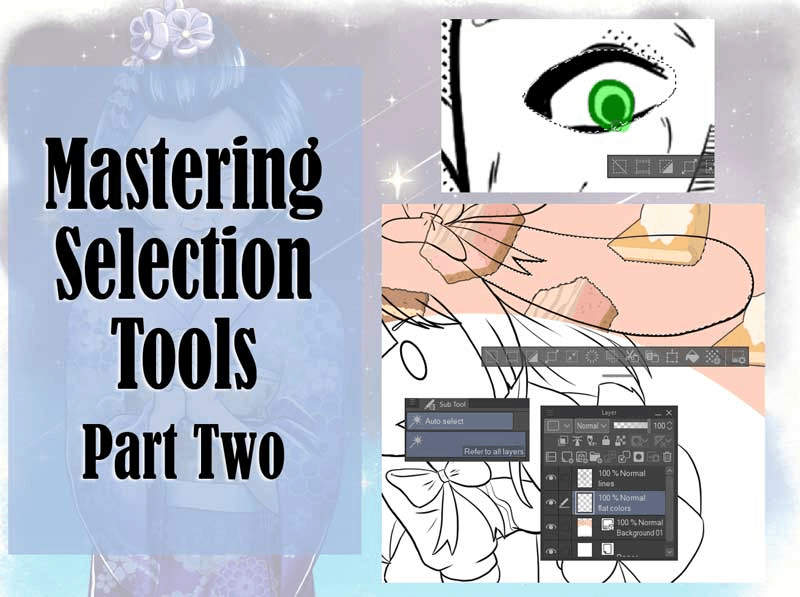Fantasy Character Illustration Workflow and Tips
Introduction
Hi and welcome to this fantasy character painting tutorial, where we'll be looking at how you can use Clip Studio Paint's tools to our advantage in creating an illustration like what you see here.
We'll go through 4 phases in this tutorial, and as a bonus emphasis, we'll be looking at Clip Studio Paint's ruler tools, to help us with adding intricate precise details on our pieces.
Now, on to the 4 main phases.
Phase 1 Concept and Ideation
Concept art is a huge topic and can't be discussed totally in this section, but here are the key points to take away from this section, as I plan to tackle how I do concepts in a later tutorial.
1. Always keep the brief in mind when doing the concept, but don't be afraid to explore new ideas and compositions. Just keep in mind some key art concepts, like creating clear silhouettes, avoiding tangents, making purposeful design decisions, and most of all, creating a nice composition that tells your story.
2. Remember that you're creating a character, so putting yourself into the shoes of the character really helps.
3. I've done character exploration sketches separately before finally deciding on this pose and composition, but the key takeaway is to keep in mind to create several compositions first.
4. In the process of creating the concept, always look for reference and inspiration. This will help you find a more solid grounded concept. Here I've use Clip Studio Paint's poseable 3D characters to flesh out a pose that I've already sketched out before. It helps a lot to see your pose from many angles to see what best tells the story you want to convey. Let me know in the comments section if you want me to show you how to pose, mold, and control the 3d characters. For the meantime, I've left the exact object you can use in your project down in the description.
5. Knowing your subject is key. Research is often needed if you're not familiar with what you want to illustrate.
Phase 2 Structure and Clarity
1. Creating the concept and establishing the structure can be done in the latter part of the concept stage, when you've already established what story you want to tell with your piece.
2. It's a more technical phase wherein knowledge of anatomy, perspective, drapery, is quintessential.
3. Here, in this phase, you make it clear to yourself, and to the audience, how your character is clothed, what items are she carrying with her, etc. Whereas in the concepting stage you can get away with just the bare minimum to convey the idea, in this stage, it really helps, especially to a beginner, to establish all the parts of the piece.
4. More masterful artists can jump straight away to the painting, lighting, phase, and paint by light, and tackle this phase of the painting intrinsically. They've already done and hid the details they had in mind in the lost edges, the shadow shapes. Since this piece is geared towards beginners, I think it helps that we establish all the structure first before we decide to lose them in shadow, or light later on. This is tremendously helpful if we choose to relight or repurpose our piece later on.
5. Doing lineart at this stage really helps in establishing structure.
6. When doing lineart, always keep in mind that when doing overlaps always keep the objects in front at a thicker line weight to imply depth.
For me, doing the flat local colors of the objects is also a part of adding the clarity. We can start to see that the tiefling's flesh is purple, and that she's wearing a bit of a complementary green.
Doing the flat colors in separate layers will help is a ton later on in the painting and lighting phase. Never underestimate the value of being organized at this stage. It pays dividends later on.
Phase 3 Lighting and Painting
1. After establishing our characters structure and color, we can now start to determine the source of light, and start painting in the shadows, highlights, subsurface scattering, and other sources of lights.
2. Again, this part is a bit more technical at first, but it doesn't mean that it doesn't leave any room for creative decisions.
3. It helps to imagine the structures as basic structures with various planes or surfaces. That way, you can simplify and abstract how light would hit these surfaces at varying angles.
4. Different surfaces behave differently under the influence of light. So it helps a lot to study and observe how real objects behave. Then you can abstract and simplify it the way you want.
Phase 4 Polish & Effects
1. After all is said and done with regards to lighting, now comes the polishing phase where we try and control every aspect of the painting using a normal layer that we can have totally control on.
2. After which, we just layer more effects and adjustments to finally unite our elements.
Bonus TIP: Creating the Magic Circle With Rulers
1. Create Circles using the Figure > Ellipse Tool. Hold Shift to create perfect circle. Select a variety of circle types.
2. Use Symmetrical Ruler with the following settings;
3. Draw on the center of the circle, an interesting pattern.
4. Disable the Ruler on the layer panel, Use Ctrl+T free transform, ctrl+click on the corner manipulators to change the perspective of the shape.
Follow the link above for the YouTube Video for further supplemental watching
























Comment